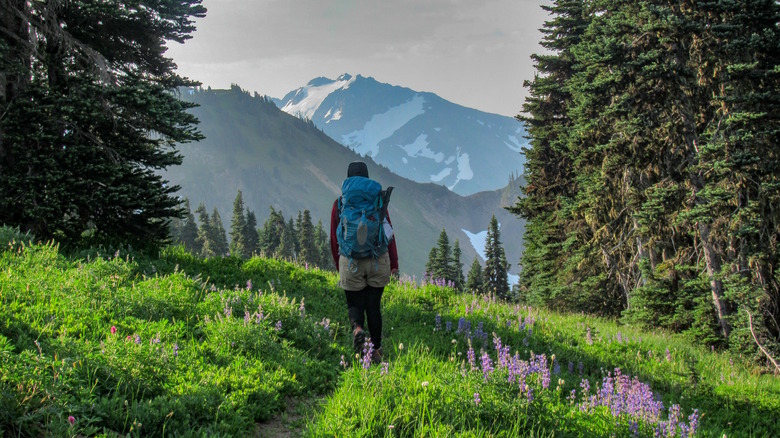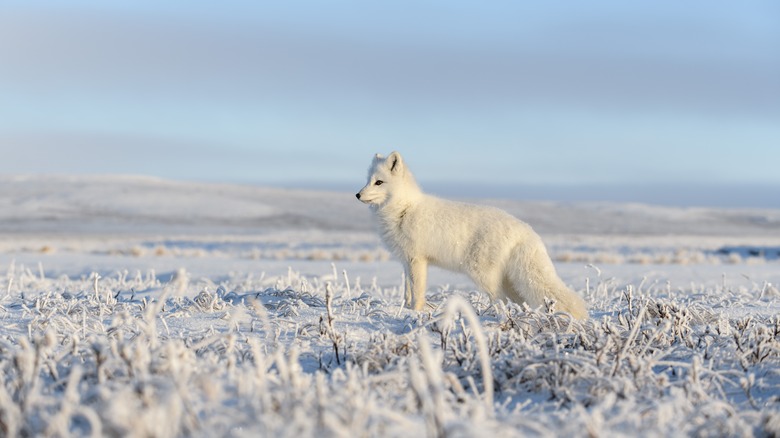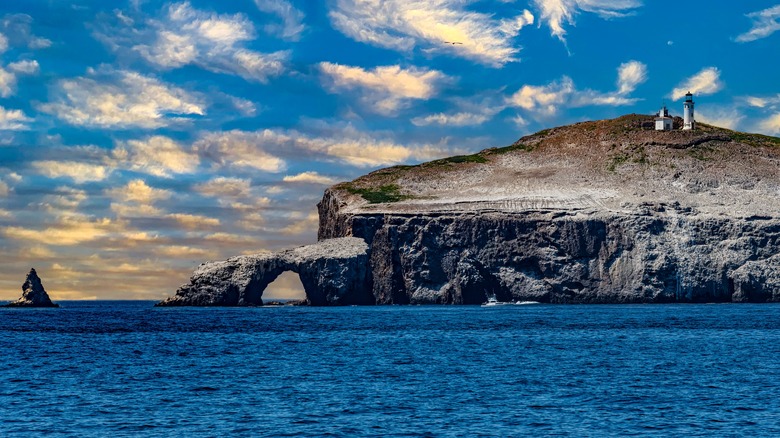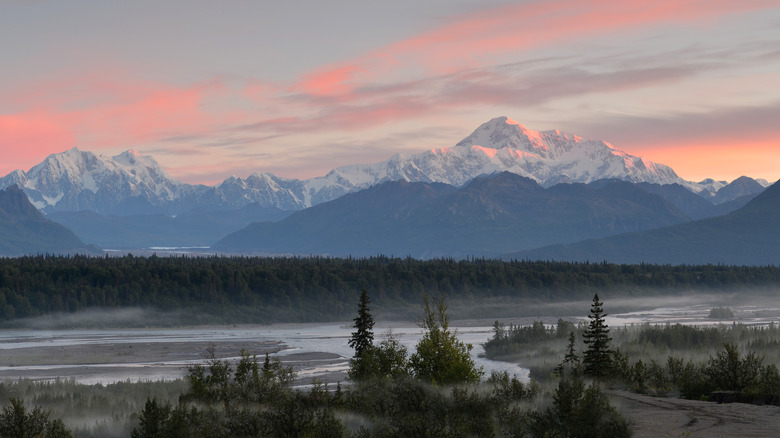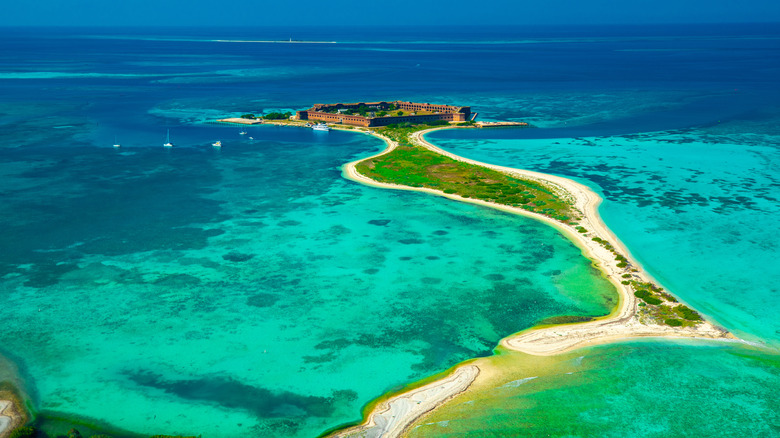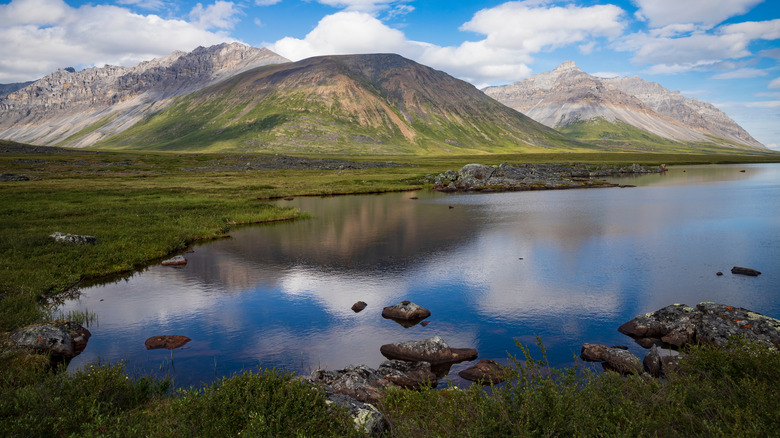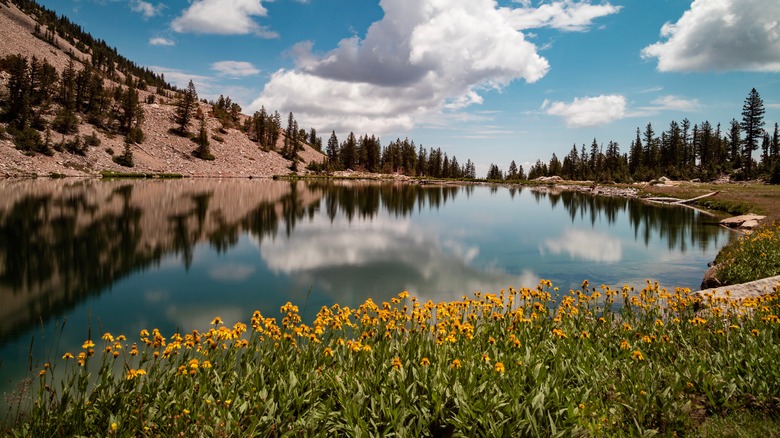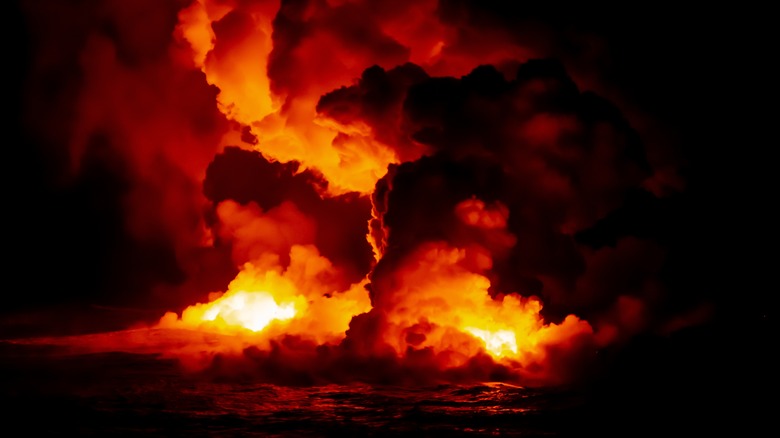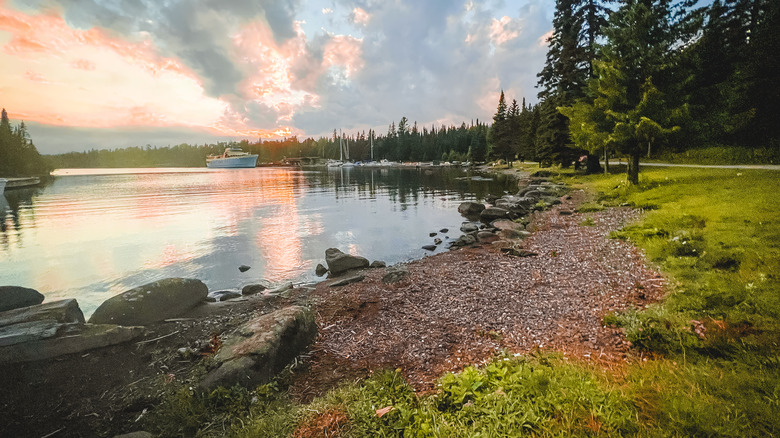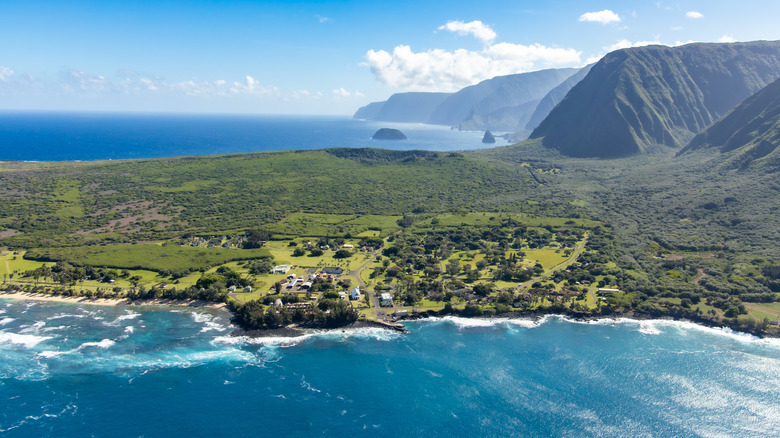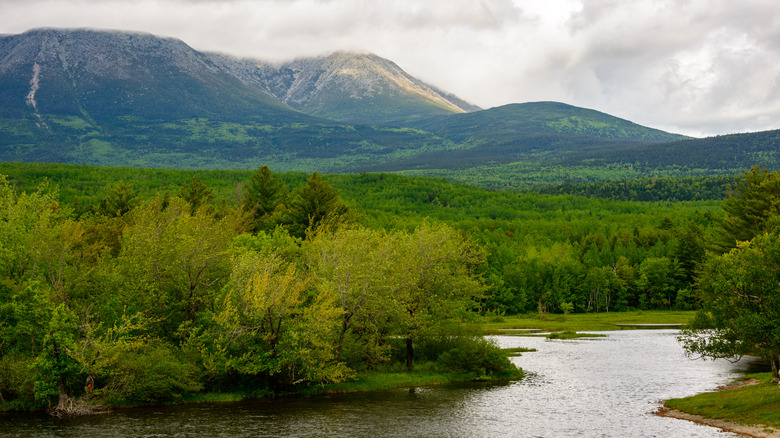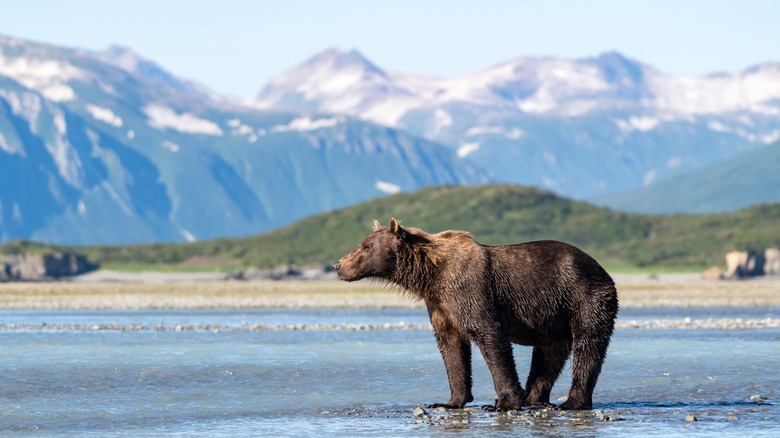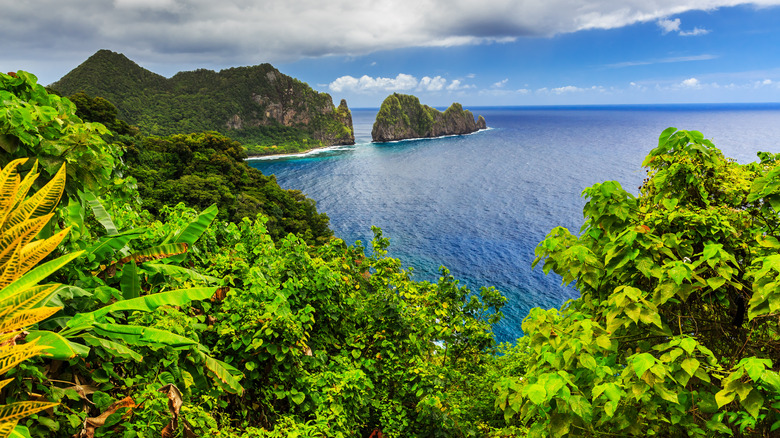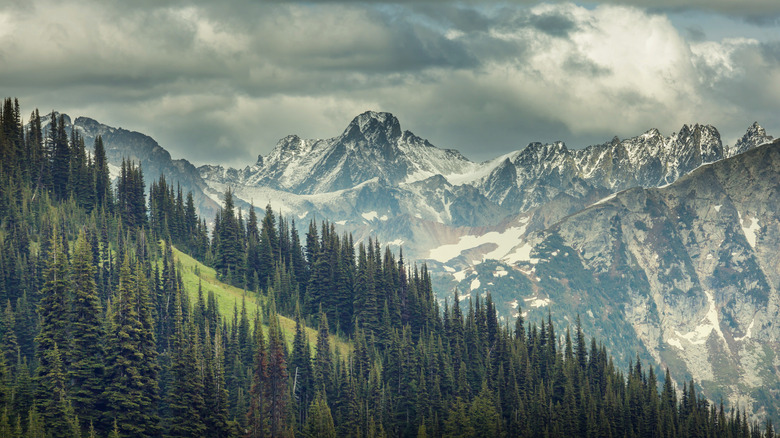13 National Parks That Are The Hardest To See
Since Yellowstone National Park was established in 1872, the U.S. government has set aside protected land for people to explore and enjoy. Some parks qualify as true wilderness, making them difficult for most people to fully see. These include elusive sanctuaries that require careful planning and resources to even reach the entrance. Visitors may have to travel long distances, take boats, or fly to the locations. Once in these parks, other factors can create challenges for even the most intrepid explorer. Untamed natural land formations, unpredictable or harsh climates, and dangerous wildlife can restrict access and make them hard to explore.
Hard-to-see parks demand dedication, perseverance, and a spirit of exploration to visit, and most require careful planning. In some cases, visitors may need to bring their own food and water, supplies, and be experienced in backcountry hiking, and some parks lack formal lodging options. However, each park also has its rewards and beckons to those seeking a myriad of experiences, from fishing to hiking to wildlife viewing. Because they are so challenging to explore, the parks offer great boons to visitors seeking solitude, adventure, and a once-in-a-lifetime experience.
1. Bering Land Bridge National Preserve - Alaska
Situated in a remote and isolated part of Alaska, the Bering Land Bridge National Park takes careful planning to reach and explore. It's one of the nation's most remote national parks — it isn't even on the road system. The park is open all year, but the National Park Service says that getting there is "challenging, costly and time-consuming." It's perhaps why only about 2,600 people visit the park each year.
Visitors fly to Nome, Alaska, to get there and then figure out their own way. There are no trails or roads to the parklands. Nor are there any campgrounds, though visitors are welcome to set up their own camps. The climate is harsh with Arctic conditions bringing in freezing temperatures, strong winds, and unpredictable weather patterns. In the winter, the park is almost impossible to visit.
Lying at the continental crossroads, the park is made up of 2.7 million acres in the Seward Peninsula. The barriers are all natural — the government charges no fees, and you don't have to secure a pass or permit, but you will need to take all of your own equipment and supplies. There is no internet or cell phone access inside the preserve. Hunting, trapping, and fishing are allowed, though visitors will need to tread carefully and practice caution. Wildlife that call the preserve home include brown bears, moose, caribou, wolves, foxes, seals, walruses, polar bears, and whales.
2. Channel Islands National Park - California
For 13,000 years, humans have walked the lands of the five remote islands that make up Channel Islands National Park off the coast of California. You can only get here by boat or small aircraft, and the National Park Service warns that there is no remedy for poor planning once you reach the island. There are no facilities to buy food or rent gear. The entire park is made up of 249,354 acres, but about half of that is underwater with the park encompassing six miles of marine sanctuary. Other than the cost of transportation to the island, there are no fees to visit the park nor do you need a permit.
The park appeals to those who love the sea and hikers. Each island has one established campground for those who want to stay overnight. The park's Santa Catalina is a particularly scenic camping site on the Californian coast. There are comparatively few species of wildlife on the islands, and none are considered dangerous. Even the two varieties of snakes are non-venomous. However, during certain times of the year, yellow jackets are active on Santa Cruz island, particularly around Scorpion Anchorage and Prison Harbor.
Visits have been climbing back to pre-pandemic levels with more than 323,000 visiting the islands in 2022. Be sure to check the status of the islands before you go, as several have experienced closures due to wildfires or to protect the local flora and fauna.
3. Denali National Park & Preserve - Alaska
It takes determination and fortitude to visit Denali National Park. The massive park only features a single road, made mostly of dirt and gravel, through six million acres of Alaskan wilderness. Even getting to the entrance is a challenge. The nearest town is more than 100 miles away, though you can take trains, motor coaches, or air taxis to get here. Once you enter the park, there are no restaurants or gas stations.
There are a few private lodges, but you can only reach them by helicopter. Private vehicles can travel the first 15 miles; beyond that, visitors must either backpack or take a bus tour, the latter of which is only available from mid-May to mid-September. Since 2021, parts of the road have also been closed because of Pretty Rock landslides, and even aircraft sightseeing tours can get canceled due to poor weather.
The park is home to America's highest and most dangerous peak, Denali, formerly known as Mt. McKinley. The mountain's fame is part of what drew nearly 428,000 to the park in 2022. Entrance fees are $15 per person for a weekly pass, and permits are required for backpacking and mountain climbing. Mountaineering permits must be obtained 60 days in advance and come with a fee. Denali was originally formed as a national park in 1917 to protect Dall sheep from overhunting. While the sheep pose little danger, there are also grizzly and black bears, wolves, caribou, and moose.
4. Dry Tortugas National Park - Florida
You'll need a boat or seaplane to get to Florida's Dry Tortugas National Park, and seeing all of it requires special scuba equipment. Most of the Florida national park is underwater. About 70 miles west of Key West, the 100-square-mile park contains seven small islands and is home to Fort Jefferson. More than 78,000 visitors made the long trek to the island in 2022 to experience the park's beautiful beaches, enjoy superlative bird watching, and explore the 19th-century fort. There is a lot to do on the island — including snorkeling and kayaking — but it is isolated, and conditions are primitive. The island does not offer any public phones, restrooms, or snack bars.
There is a $15 fee for a weekly pass per person, which doesn't include any ferry or plane fees to the island. If you want to camp, you'll need to bring a cash or check, as credit and debit cards are not accepted. There is a lot of wildlife on the island, especially in the waters, though swimmers will need to stay away from sharks, jellyfish, and the coral, especially the fire coral. Fishing is allowed in some areas, but lobstering is forbidden. When swimming, you'll also need to be aware of strong currents. The National Park Services warns that it is a long way to hospital care, so park visitors must exercise caution.
5. Gates of the Arctic National Park and Preserve - Alaska
Covering more than 8 million acres, the Gates of the Arctic National Park & Preserve is one of the largest and most remote national parks in the U.S. It has no roads, trails, or signs but is filled with mountain peaks, glacial arctic valleys, winding rivers, and scenic lakes. The Arctic climate means temperatures are often frigid, and visitors must contend with high winds and unpredictable weather patterns. In the winter, temperatures drop as low as -50 degrees Fahrenheit. In addition to the lack of facilities and services, communication options are also limited. Visitors should bring satellite phones and/or emergency beacons.
Fewer than 10,000 people made the trek to this park in 2022, as explorers need to be highly self-reliant. Most people access the park by small aircraft or by backpacking from neighboring areas. The National Park Service says even experienced hikers consider six miles to be a full day's travel in the Gates of the Arctic. However, visitors are rewarded with the Gates of the Arctic's breathtaking landscapes and can enjoy hiking, birding, camping, fishing, and hunting. Those not experienced with backcountry skills can explore the park through flightseeing tours or guide-led fishing expeditions.
The park is the habitat of a large Western Arctic caribou herd, and other wildlife includes wolverines, wolves, as well as grizzly and black bears. Visitors are encouraged to stop at one of the park's visitor centers to learn about bear safety and to borrow a bear-resistant food container.
6. Great Basin National Park - Nevada
The stars shine brightly in the Great Basin National Park, land located near the start of America's loneliest roads. While the beauty draws more than 142,000 visitors each year, some challenges make it difficult to see and visit the park. To start, getting here demands you drive through vast and sparsely populated regions with limited services and lodging. Great Basin features high elevations that can cause altitude sickness, and the region experiences wide weather fluctuations from alpine environments to desert landscapes. Other hazards include lightning and electrical storms, sun exposure, hypothermia, avalanche dangers, and abandoned mines. Some of the mountainous areas of the park are inaccessible during the winter because of snow accumulation. There is no public Wi-Fi in the park, and cellular service can be spotty.
The 77,000-acre park includes the Lehman caves, many pine groves, and Nevada's highest mountain, Wheeler Peak. The caves are a popular destination, filled with bats. Other park inhabitants include bighorn sheep, shrews, porcupines, beavers, and ringtail cats. The most dangerous inhabitants are mountain lions and rattlesnakes. You don't have to pay to enter the park. While there are fees to tour the caves and camp overnight, the park is renowned for its designation as an International Dark Sky Park.
7. Hawaii Volcanoes National Park - Hawaii
As its name implies, Hawaii Volcanoes National Park is home to volcanoes and two of them, Kilauea and Mauna Loa, are still active. While the lava tubes are underrated attractions in Hawaii, it is an activity to approach with caution. Ongoing volcanic activity can cause trail closures, changes in viewing areas, and altered access points, making the park's 333,086 acres hard to see when the volcanos are at their busiest. "Vog," or volcanic smog, can also affect air quality, creating dangers for visitors with respiratory concerns.
The park attracts visitors as an International Biosphere Reserve and a UNESCO World Heritage site. The challenges of seeing the park are also what draw more than 1.5 million people to the park each year, making this park the most visited of all the ones in this article. The National Park Service warns that parking lots can fill up by 10 a.m., especially between December and January. Park rangers insist that people stay on the trails, as concealed sinkholes, unstable cliff edges, and volcanic gasses can make off-trail exploring dangerous.
8. Isle Royale National Park - Michigan
Isle Royale National Park is noted for being a piece of pristine wilderness floating in Lake Superior, which means it isn't for the faint of heart or the impatient. Access is by ferry or seaplane only, and vehicles are not allowed on the island. A ferry trip can take anywhere from 1.5 to 7 hours, depending on weather conditions, and fog and storms can impede seaplane travel. Ferry ports to the islands are also remote and require a journey to get there.
The park consists of one main island and more than 400 smaller ones. There are very few facilities on the island, and visitors will need to bring their own food, water, and camping supplies. Communication options are limited, and there are very few emergency services. Trails are rugged and most camping is highly primitive. The park is open for a limited time each year, closing to visitors from November 1 to April 15.
Averaging around 25,000 visitors each year, the park is the site of 10 shipwrecks that divers can explore. There are 165 miles of trails throughout the park, but bikes and other wheeled devices are not allowed on them. It's almost impossible to pick up cell phone signals, and if you do, it is likely from a Canadian tower, and you'll pay international fees. So expect to use paper maps for getting around. Permits are required for camping.
9. Kalaupapa National Historic Park - Hawaii
Located on the remote island of Molokai, Hawaii, Kalaupapa was a leprosy settlement and continues to host those who were banished here. To preserve its history and the privacy of the residents, access to this park is restricted, and visitors must obtain a permit or join a guided tour to visit. While it is important everywhere in Hawaii to be a respectful tourist, the history of this park makes it particularly important when visiting Molokai.
When leprosy was introduced to Hawaii in the mid-1800s, the king banished those who contracted it to two settlements on Molokai. More than 8,000 people died here. Kalaupapa served as a natural (an actual) prison, as residents were forbidden from leaving here until 1969. The peninsula is surrounded by the ocean on three sides and a 2,000-foot vertical cliff on the fourth side.
In 2023, no tour operators were allowed to visit, further restricting access to the park. Until a new tour company is established, the only visitors allowed are guests of residents. If you're fortunate enough to visit, you'll need to bring your supplies and hike a steep, challenging 3.5-mile trail to the park. Overnight camping is prohibited.
10. Katahdin Woods and Waters National Monument - Maine
Far up in the northern woods of Maine, Katahdin Woods and Waters National Monument provides a serene and remote wilderness experience. Since it's a dark sky sanctuary, there are few services in the park, and getting here requires driving through rural and sparsely populated areas. All roads to the park area and within it are unpaved. During the winter, much of the park is completely inaccessible because of snow. In early spring, road conditions get rough because of snow melt, making them muddy and dangerous.
Park guests must bring their own supplies and equipment, as the park does not have amenities or visitor centers. In fact, there are very few signs and only a handful of toilets. But the approximately 43,000 visitors who went here in 2022 were able to enjoy solitude and a chance to hike, bike, ski, snowshoe, and camp. One of the nation's newer national parks, it covers 87,500 acres around Penobscot, Maine. The land was donated by Elliotsville Plantation and Roxanne Quimby, the owner of Burt's Bees.
GPS coverage is hard to access and often unavailable, so you'll need to carry a printed map or download the NPS app for offline use. The GPS is also known to send people to unmaintained roads that aren't suitable for passenger cars, RVs, or inexperienced drivers. Visitors should also be aware of the park's large population of black bears.
11. Katmai National Park & Preserve - Alaska
Another remote Alaskan park, Katmai National Park & Preserve is home to dozens of volcanos and has more brown bears than any other national park. One of the most underrated parks for incredible views of wildlife, Katmai is home to thousands of bears and 9,000 years of human history. However, getting here takes planning and effort. Accessing the 40-million-acre park requires a boat or small aircraft, and the park welcomed around 34,000 visitors in 2022. The most accessible part of the park is Brooks Camp, where people go to view brown bears, fish, take bus tours, and begin backcountry adventures.
The park's purpose is to study active volcanism around the Valley of Ten Thousand Smokies and protect the wildlife of the subarctic ecosystem. Many, but not all, park activities require permits, especially during salmon spawning season. Camping requires a permit, and there are many restrictions on how long, where, and when a campsite can be active. The NPS recommends erecting electric fences around campsites to discourage bear visitors. Fewer than five miles of the park's trails are maintained, and since the land is so difficult to access, the National Park Service hosts online activities for people to experience the wonder of Katmai, such as bear webcams and the Fat Bear Week tournament.
12. National Park of American Samoa - American Samoa
The National Park of American Samoa is far from the mainland of North America. Nestled in the Pacific Ocean, nearly 2,600 miles southwest of Hawaii, the park is spread out over several islands. To get here, you first have to fly into Pago Pago, the capital of American Samoa, and flights are limited. As of 2023, there were only two round-trip flights a week from Hawaii, though there are more if your departure point is Australia, New Zealand, or Fiji.
Once you are in American Samoa, you'll need to access the park by boat or small aircraft. Since the onset of the pandemic, annual visitors have fallen from a high of 60,006 in 2019 to 1,887 in 2022. The park itself comprises three volcanic islands: Ofu, Ta'ū, and Tutuila. The rest of the park, about 4,000 acres, is underwater.
In addition to protecting the paleotropical rainforests, the purpose of the park is to preserve the 3,000-year-old Samoan culture. Visitors are asked to be respectful of traditions and practices and to follow Fa'asamoa, aka The Samoan Way. This includes asking permission before taking photos or using the beach. Sunday is a day of rest and quiet, and activities such as swimming are usually not allowed. Do not eat or drink while walking through a village. Before visiting, you'll also need to learn local customs for entering a traditional home, observing Sā (quiet time), and drinking 'ava.
13. North Cascades National Park - Washington
Known for its vast and remote wilderness, North Cascades National Park has only one route leading in, and that road is often closed due to avalanches. There is limited road access to much of the park, which features a diverse landscape of mountain peaks, dense forests, and alpine lakes, and visitors will need to hike or boat to explore most of it. In addition to avalanches limiting access, heavy snowfall and (in recent years) forest fires have also closed areas of the park.
While beautiful, North Cascades is not an easy park to hike. Considered one of the least visited parks (with 30,156 guests in 2022) and most dangerous, the park is home to a trek that has even experienced hikers biting their nails. Jack Mountain, which rises 9,066 feet, challenges visitors with a high level of climbing difficulty. The park is also inhabited by diverse wildlife, including black bears, grizzly bears, wolverines, grey wolves, Canada lynx, cougars, and bobcats. Visitors should practice bear safety and keep a respectful distance.
14. Methodology
The National Park Service manages 63 national parks. While there is no objective ranking of which parks are most difficult to see, there are many published opinions of experienced travelers, rangers, and those who study the parks. This list is based on discussions with travelers, descriptions from travel sites such as Fodor's, and a review of National Park Service information about each of its parks. Our selection of parks took into consideration accessibility, the size of the park, amount of visitors, the appeal it has to particular types of visitors, local wildlife, and permit requirements to visit.
